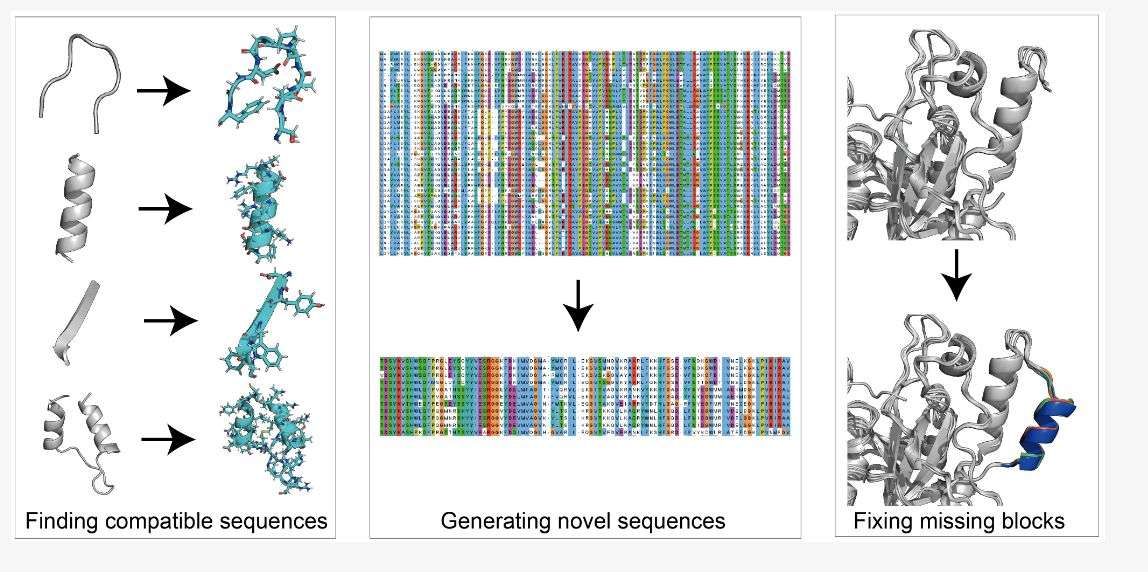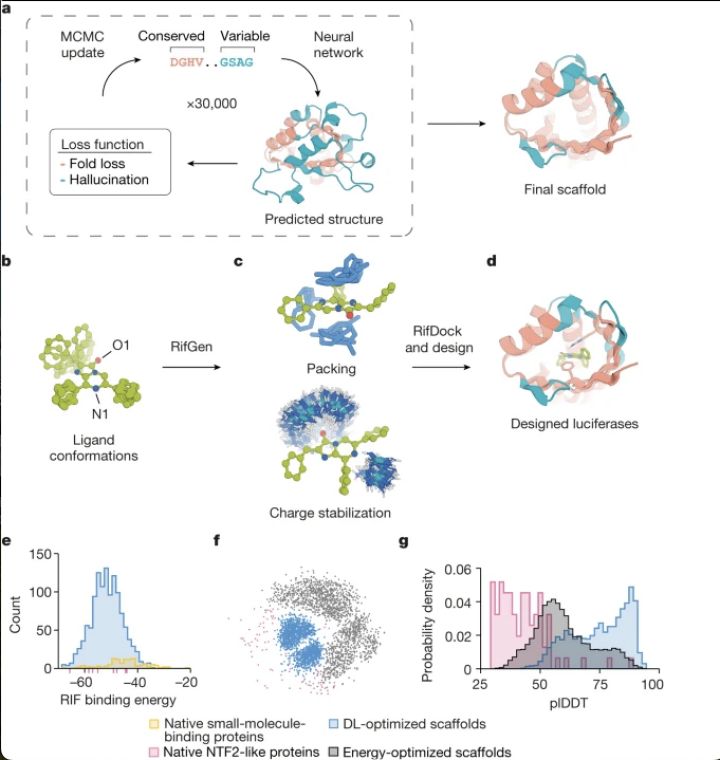De Novo Enzyme Design for Green Chemistry is a groundbreaking scientific technique that involves designing and engineering new enzymes from scratch. This approach is pivotal for Green Chemistry, a field of science that is gaining increasing attention in our quest for sustainable development. By creating catalysts that can drive reactions with greater efficiency, selectivity, and sustainability in comparison to traditional chemical methods, De Novo Enzyme Design contributes to the reduction of hazardous substances, conservation of resources, and overall environmental protection.
 De Novo design of food enzymes (Xinglong W., et al., 2023)
De Novo design of food enzymes (Xinglong W., et al., 2023)
Service Process
Here is our organized, step-by-step service process designed specifically for De Novo enzyme design in green chemistry:
- Initial Consultation: We begin our service process with an in-depth initial consultation. During this stage, we aim to fully comprehend your specific needs and objectives. We believe that understanding our clients' goals is the foundation of developing a successful, personalized solution.
- Computational Design of New Enzymes: After gaining a clear understanding of your requirements, we move on to the computational design of new enzymes. To ensure the highest level of accuracy and effectiveness, we employ state-of-the-art software tools in this process. Our team of experts meticulously designs and models new enzymes based on your needs.
- Laboratory Synthesis and Testing: Once we have a robust enzyme design, our team proceeds to synthesize the proposed enzymes in the laboratory. This critical stage involves creating the physical enzyme based on our computer-generated designs.
- Verification of Enzyme Functionality: Post-synthesis, it is essential to confirm that the new enzymes function as expected. We conduct rigorous testing to verify their functionality, ensuring that they perform their intended roles effectively and efficiently.
- Final Delivery of Designed Enzyme: After confirming the successful functionality of the new enzymes, we move to the final delivery. We provide you with the designed enzymes, ready for implementation in your specific application.
- Continuous Support for Implementation: We understand that our responsibility does not end at the delivery of the enzymes. We offer continuous support for the implementation of the designed enzymes in your processes, ensuring they work seamlessly and deliver the desired results.
We're here to assist you. If you have any questions, need more information, or would like to discuss a potential project, please don't hesitate to contact us. Our team is always eager to help and share our expertise.
Applications
| Application |
Description |
| Pharmaceutical Industry |
De novo enzyme design for green chemistry is utilized in the pharmaceutical industry to create novel enzymes that can catalyze specific reactions efficiently. These enzymes can be tailored for drug synthesis, enhancing selectivity, yield, and reducing the need for hazardous reagents. They contribute to sustainable drug manufacturing processes. |
| Biofuel Production |
In biofuel production, de novo enzyme design is employed to engineer enzymes capable of breaking down lignocellulosic biomass into fermentable sugars. These customized enzymes improve the efficiency of biofuel production processes, reducing reliance on fossil fuels and minimizing environmental impact. |
| Agricultural Chemistry |
De novo enzyme design is applied in agricultural chemistry to develop enzymes that enhance nutrient uptake in plants, improve soil fertility, or aid in pest control. These enzymes can promote sustainable agricultural practices by reducing the need for chemical fertilizers and pesticides, thus minimizing ecological harm. |
| Food Industry |
Enzyme design is used in the food industry to create enzymes that facilitate food processing and enhance product quality. These enzymes can improve texture, flavor, and nutritional value while reducing the need for harsh chemical additives. This contributes to the development of more sustainable and healthier food products. |
| Bioremediation |
Enzyme design is utilized in bioremediation to engineer enzymes capable of breaking down contaminants in polluted environments. These enzymes accelerate the natural degradation processes, making it possible to restore contaminated sites more efficiently and effectively, thus contributing to environmental cleanup efforts. |
Case Study
Luciferase is often regarded as part of green chemistry due to its role as a biocatalyst, enabling chemical reactions under mild conditions, thereby reducing energy consumption and waste production. The figure below illustrates the generation of idealized scaffolds and computational design of de novo luciferases. (a) Family-wide hallucination. Sequences encoding proteins with the desired topology are optimized by Markov chain Monte Carlo (MCMC) sampling with a multicomponent loss function. Structurally conserved regions (peach) are evaluated on the basis of consistency with input residue–residue distance and orientation distributions obtained from 85 experimental structures of NTF2-like proteins, whereas variable non-ideal regions (teal) are evaluated on the basis of the confidence of predicted inter-residue geometries calculated as the KL divergence between network predictions and the background distribution. The sequence-space MCMC sampling incorporates both sequence changes and insertions and deletions to guide the hallucinated sequence towards encoding structures with the desired folds. Hydrogen-bonding networks are incorporated into the designed structures to increase structural specificity. b–d, The design of luciferase active sites. (b) Generation of luciferase substrate (DTZ) conformers. (c) Generation of a Rotamer Interaction Field (RIF) to stabilize anionic DTZ and form hydrophobic packing interactions. (d) Docking of the RIF into the hallucinated scaffolds, and optimization of substrate–scaffold interactions using position-specific score matrices (PSSM)-biased sequence design. (e) Selection of the NTF2 topology. The RIF was docked into 4,000 native small-molecule-binding proteins, excluding proteins that bind the luciferin substrate using more than five loop residues.
 De novo design of luciferases (Andy Hsien-Wei Yeh, et al., 2023)
De novo design of luciferases (Andy Hsien-Wei Yeh, et al., 2023)
FAQs
Here are some frequently asked questions about De Novo Enzyme Design and its role in Green Chemistry. If you have more specific or detailed questions, don't hesitate to get in touch with us directly.
Q: Can you define green chemistry for me?
A: Green chemistry, often referred to as sustainable chemistry, is essentially a design philosophy that is deeply rooted in the idea of reducing or completely eliminating the use and production of harmful substances during the design, manufacturing, and usage of chemical products. The ultimate goal of green chemistry is to create a future where all chemical processes are not only safe and energy-efficient, but also have minimal impact on our environment.
Q: How does De Novo Enzyme Design contribute to the principles of green chemistry?
A: De Novo Enzyme Design is a highly potent tool in the realm of green chemistry. This groundbreaking technique grants us the ability to engineer new enzymes that can catalyze chemical reactions in a manner that's not only more efficient but also more selective and sustainable than conventional chemical methods. This inherently results in fewer by-products, significantly lower energy consumption, and minimal environmental impact.
Q: Could you explain the process of De Novo Enzyme Design to me?
A: Certainly! The process of De Novo Enzyme Design involves the application of advanced computational methods to design completely new enzymes from scratch. Once these designs are meticulously crafted, they are then synthesized in the laboratory and subjected to rigorous testing to confirm their functionality and efficiency. It's a highly intricate process that necessitates the combination of cutting-edge technology with a profound understanding of biochemistry.
Q: What are some ways De Novo Enzyme Design can be applied in the field of green chemistry?
A: The potential applications of De Novo Enzyme Design in green chemistry are both diverse and far-reaching. Examples include the production of biofuels, controlling pollution levels, and the development of environmentally friendly alternatives to conventional chemical products. Beyond this, it can also be utilized in the pharmaceutical industry for the creation of new drugs and therapeutic treatments.
Q: Has De Novo Enzyme Design been proven to be effective?
A: Absolutely, there are several instances of successful application of De Novo Enzyme Design that have been documented in scientific literature, which underscore its potential in various scientific and industrial fields.
Q: What makes enzymes a better choice for chemical reactions over traditional catalysts?
A: Enzymes offer a myriad of advantages over traditional chemical catalysts. They can operate under mild conditions, exhibit high selectivity which drastically reduces the production of by-products, and are biodegradable. These qualities make them an ideal choice for green chemistry.
Q: Is it possible to create any enzyme using De Novo Enzyme Design?
A: The field of De Novo Enzyme Design is continuously evolving, and recent advancements have indeed broadened the spectrum of enzymes that can be engineered using this technique. However, it's crucial to understand that each design is a complex process that calls for sophisticated computational toolkits and a high level of expertise in biochemistry.
Q: How can I contribute to De Novo Enzyme Design in the context of Green Chemistry?
A: We are always eager to foster collaborations and establish partnerships with individuals interested in this field. If you're interested, we encourage you to get in touch with us to discuss potential opportunities.

































 De Novo design of food enzymes (Xinglong W., et al., 2023)
De Novo design of food enzymes (Xinglong W., et al., 2023) De novo design of luciferases (Andy Hsien-Wei Yeh, et al., 2023)
De novo design of luciferases (Andy Hsien-Wei Yeh, et al., 2023)